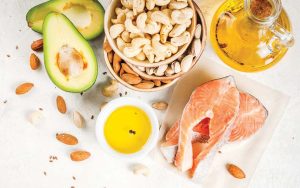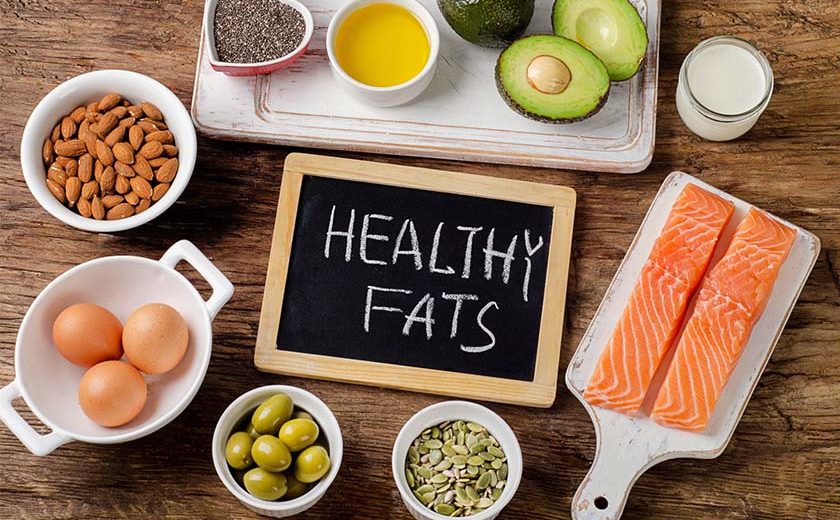Fat consumption can get tricky, for there is quite a bit of differentiating to do, for the sake of your health. Most fatty foods tend to taste great, and the good news is, some of these fats are actually good for your health. It’s the bad fats, however, that we’re concerned about.
Saturated fat
Eating a lot of saturated fat increases your blood cholesterol, in particular increasing the bad (LDL) cholesterol. Choosing foods with healthier fats instead helps to balance your blood cholesterol, by increasing the good (HDL) cholesterol and lowering the bad (LDL) cholesterol, which reduces your risk of heart disease.
Saturated fat mainly comes from the fat you can see on meat and chicken, from dairy products and from some plant foods like palm and coconut oil. It can be found in processed foods like biscuits, pastries and takeaway foods that have used ingredients like butter, palm oil (often simply called vegetable oil), cheese and meat. For heart health, it is recommended saturated fat be only 7% of your total energy intake. For example, for an average adult intake of 8700 kilojoules, 7% is about 16 grams of saturated fat.
Trans fat
To reduce the risk of heart disease, limit trans fat as much as possible. Trans fat increases our risk of heart disease by increasing the bad (LDL) cholesterol and lowering the good (HDL) cholesterol in our blood.
Small amounts of trans fats naturally occur in dairy products, beef, veal, lamb and mutton. The way some fats and oils are processed during manufacturing produces artificial or ‘industrially produced’ trans fats. They’re in foods that use partially hydrogenated vegetable fats, like deep-fried foods and baked foods like biscuits, cakes, pastries and buns. Less than 1% of total energy should come from trans fat.
Tips for eating less saturated and trans fats
- Choose reduced fat milk, cheese and yoghurt.
- On packaged food products in the supermarket, check the ingredients list for ‘hydrogenated oils’ or ‘partially hydrogenated vegetable oils’ and avoid foods with these.
- Eat less bought cakes, biscuits and pastries. Also limit takeaway food like hamburgers, pizza and hot chips. These foods should only be eaten sometimes and in small amounts.
- Trim all the fat you can see off meat, and remove skin from chicken.
- Avoid processed meat (e.g. sausages and salami).
- Eat fish instead of meat 2–3 times a week, and choose legume or bean-based meals twice a week.

Mono & Poly: Are you getting enough of these good fats?
Omega-3 and Omega-6
How much do you include healthier fats in your diet to help reduce the risk of heart disease? Healthier fats include monounsaturated fats and polyunsaturated fats (omega-3 and omega-6). These fats help the cholesterol balance in your blood by decreasing the bad (LDL) cholesterol and increase the good (HDL) cholesterol. Replacing saturated and trans fats with healthier ones helps to lower your risk of heart disease.
Make sure you have these healthier sources of fat in your healthy balanced diet.
Monounsaturated fat
Sources of monounsaturated fat include:
- Avocados
- Almonds, cashews and peanuts
- Cooking oils made from plants or seeds like canola, olive, peanut, soybean, rice bran, sesame and sunflower oils
Polyunsaturated fat
Sources of polyunsaturated fat (both omega-3 and omega-6) include:
- Fish
- Tahini (sesame seed spread)
- Linseed (flaxseed) and chia seeds
- Soybean, sunflower, safflower, and canola oil, and margarine spreads made from these oils
- Pine nuts, walnuts and brazil nuts.
Omega-3
Omega-3 fats are a type of polyunsaturated fat that, like other dietary polyunsaturated fats, reduce your risk of heart disease. Omega-3s can:
- Lower heart rate and improve heart rhythm
- Decrease the risk of clotting
- Lower triglycerides
- Reduce blood pressure
- Improve blood vessel function and delay the build up of plaque (a fatty substance) in coronary arteries
Try to include omega-3 fats from all of these 3 sources as part of a healthy eating pattern:
Marine: Omega-3 is found mainly in oily fish like tuna, salmon, sardines and blue mackerel. Other good sources are fish like barramundi and flathead, and seafood like scallops and mussels. Try to eat 2–3 serves a week.
Plants: Good sources of plant-based omega-3 include walnuts, linseed (flaxseed), chia seeds and oils and spreads made from canola or soybean. Aim to include foods that provide at least 1 gram of plant-sourced omega-3 every day.
Animals: Omega-3 is also found in animal products like eggs, chicken and beef.
For people who don’t eat fish, omega-3 capsules or liquids can also help supplement your intake.
Omega-6
Omega-6 is a type of polyunsaturated fat that lowers LDL cholesterol. Eating foods with unsaturated fat, including omega-6, instead of foods high saturated and trans fats helps to get the right balance for your blood cholesterol (lower LDL and increase HDL).
Easy ways to eat more healthy fats
- Include 2–3 serves of fish a week (100–150 g per serve).
- Use nuts and seeds in your breakfast. Sprinkle ground linseed on cereal or try a handful of almonds sprinkled over yoghurt.
- A handful (about 30 g) of unsalted nuts makes a healthy snack any time of the day.
- Use oils made from olive, sunflower, canola and safflower oils in cooking and try tahini, nut butters or avocado on sandwiches and toast.
- Choose wholegrain bread with linseeds.
- Add foods containing good fats to your main meals. Use avocado, pine nuts or sesame seeds in salads. Sprinkle nuts or seeds over vegetables.
- Add walnuts, ground or whole linseeds and chia seeds to stir fries.
References:
www.heartfoundation.org.au
www.heart.org


